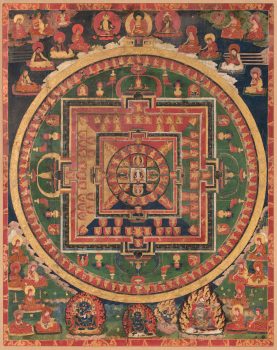Tibet
17th century







Tibet
17th century







A mandala depicts the palace of a deity populated by his or her retinue. In its most basic form it is a circle inside a square with the main deity at its center. Here Sarvavid Vairochana, white with four faces, is seated in a meditation posture. He is surrounded at the cardinal directions by four buddhas that are specific to this mandala. Although many practices focused on Vairochana were eventually eclipsed in importance by those of other deities, practices related to the All-Knowing Buddha Vairochana have maintained their popularity. This is because of the functional nature of the rituals, which are often used in funerary and consecration ceremonies.
A religious movement that originated in India around the fifth to seventh century with sacred writings and esoteric teachings and practices transmitted from teacher to student through initiation. These remain an important part of Hinduism and Buddhism today.
A contemplative practice in which a person uses concentration and visualization to achieve aims such as transforming the mind and generating feelings of compassion. Techniques include focusing on breathing or visualizing oneself as a deity.
A meditation technique primarily used in tantric practice that involves imagining a deity in one’s mind or imagining oneself becoming a deity and carrying out various activities. Such techniques are intended to help a practitioner transform ordinary perception and achieve enlightened qualities.
A geometrically shaped tool used for meditation and visualization in Buddhist practice. It is a representation of the palace of a deity and the Buddhist conception of the cosmos.
Today, Tibetans primarily inhabit the Tibetan Plateau, situated between the Himalayan mountain range and the Indian subcontinent to the west, Chinese cultural regions to the east, and Mongolian cultural regions to the northeast. During the 7th to 9th century, Tibetan rulers expanded their empire across Central Asia, and established Buddhism as the state religion.
Get the latest news and stories from the Rubin, plus occasional information on how to support our work.